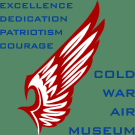Most of the jet aircraft at the Cold War Air Museum were equipped with ejection seats when they were in military service.

One of the first actions on arrival is to check and insure that these seats have been disarmed or disabled. While this makes the aircraft safe to work on and to move around in, it begs the question- “Hot or Cold”?
Should the seats be “hot” during flight or “cold”? Because the use of the ejection seat has a training requirement prior to useage, the consensus has been to leave the ejection seats “cold” and rely on the robust nature of the airframe and the skills of the pilot should an emergency occurr and require an emergency landing. After all, no one is shooting at us over Lancaster.
In fact, the general consensus is that barring an on board fire, or the total loss of control function, the occupants are better off “riding it down” in the event of an emergency as the aircraft we fly are exteremely durable and robust. But enough of this, lets talk about where ejection seats came from and how they were developed.
A bungee-assisted escape from an aircraft took place in 1910. In 1916 Everard Calthrop, an early inventor of parachutes, patented an ejector seat using compressed air.
The modern pattern for a plane was invented by Romanian inventor Anastase Dragomir and its design was successfully tested on August 25, 1929 at the Paris-Orly Airport near Paris and in October 1929 at Băneasa, near Bucharest.
The first ejection seats were developed independently during World War II by Heinkel and SAAB. Early models were powered by compressed air and the first aircraft to be fitted with such a system was the Heinkel He 280 prototype jet fighter in 1940.

After World War II, the need for such systems became pressing, as aircraft speeds were getting ever higher, and it was not long before the sound barrier was broken. Manual escape at such speeds would be impossible. The United States Army Air Forces experimented with downward-ejecting systems operated by a spring, but it was the work of Sir James Martin and the British company Martin-Baker that was to prove crucial.
Early seats used a solid propellant charge to eject the pilot and seat by igniting the charge inside a telescoping tube attached to the seat. Effectively, the seat was fired from the aircraft like a bullet from a gun. As jet speeds increased still further, this method proved inadequate to get the pilot sufficiently clear of the airframe and increasing the amount of propellant risked damage to the occupant's spine, so experiments with rocket propulsion began. The F-102 Delta Dagger was the first aircraft to be fitted with a rocket-propelled seat, in 1958. Martin-Baker developed a similar design, using multiple rocket units feeding a single nozzle. This had the advantage of being able to eject the pilot to a safe height even if the aircraft was on or very near the ground.

 One of the items received was a replacement engine for one of our Cold War Air Museum. Mi-2 helicopters. This turned out to be an example of "Just in Time" scheduling for our flyer, Bord 211.
One of the items received was a replacement engine for one of our Cold War Air Museum. Mi-2 helicopters. This turned out to be an example of "Just in Time" scheduling for our flyer, Bord 211. There is a saying to the effect that "The worst turbine engine's worst day is better than the best piston engine's best day", even so, turbine engines do have problems from time to time. It turns out that this was the time for the right engine in Bord 211. When a bearing went out, the comment was that it sounded as if "the engine ate a bunch of walnuts". Fortunately the engine did not "eat a bunch of walnuts", as the turbine blades are fine. With a maintenance crew on hand, the old engine was out in about three hours and the new engine went in just about as quickly.
There is a saying to the effect that "The worst turbine engine's worst day is better than the best piston engine's best day", even so, turbine engines do have problems from time to time. It turns out that this was the time for the right engine in Bord 211. When a bearing went out, the comment was that it sounded as if "the engine ate a bunch of walnuts". Fortunately the engine did not "eat a bunch of walnuts", as the turbine blades are fine. With a maintenance crew on hand, the old engine was out in about three hours and the new engine went in just about as quickly.  With maintenance and flight experience on hand. The new engine was closely monitored through a number of exercise cycles before it was ignited.
With maintenance and flight experience on hand. The new engine was closely monitored through a number of exercise cycles before it was ignited.  After a number of runups with the igniters off to insure that everything looked good, the new engine was started and ran flawlessly. The long "extension cord" is a very heavy duty APU power cord used to supply battery power during the engine exercise and starting sequences.
After a number of runups with the igniters off to insure that everything looked good, the new engine was started and ran flawlessly. The long "extension cord" is a very heavy duty APU power cord used to supply battery power during the engine exercise and starting sequences. The old engine will be inspected and repaired.
The old engine will be inspected and repaired.







































